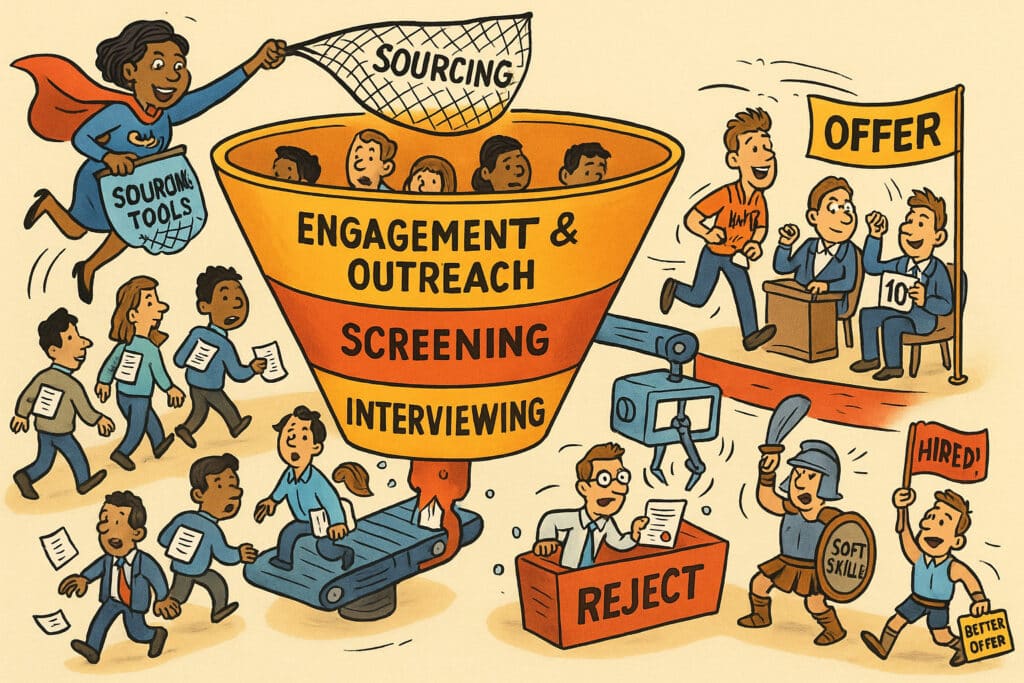Remote hiring isn’t just a 2020 buzzword anymore—it’s the way modern companies win talent, save on costs, and build truly diverse teams. But let’s be real: remote hiring has its quirks. Scheduling across time zones, sorting through the sea of applicants, and making candidates feel connected (without the in-person handshake) is no joke.

I’ve watched HR teams go from “What’s Zoom?” to running fully virtual hiring cycles. What separates the success stories? The right tech stack—tools that actually work together, automate the boring stuff, and make life easier for both recruiters and candidates.
Why Remote Hiring Isn’t Going Anywhere
Hiring remotely means you’re no longer fishing in your local pond—you get access to a global talent pool, you save on overhead, and you build teams that look (and think) differently. But it also means you need a process that moves fast, feels personal, and scales, no matter where your next star candidate lives.
1. Attract and Source Candidates—Smarter, Not Harder
Remote jobs get flooded with applications—most of them not the right fit. That’s where smart sourcing tools step in:
- LinkedIn Recruiter: Perfect for outbound searches anywhere in the world.
- Wellfound (AngelList Talent): If you’re a startup or remote-first company, this is your playground.
- hireEZ / SeekOut / Findem: AI tools that build remote-ready pipelines and do the heavy-lifting for you.
- Remote Job Boards: FlexJobs, We Work Remotely, and Remote OK bring in applicants who actually want remote roles.
Pro tip: Brush up on Boolean and skill-based searches. It’s the secret sauce to finding the needle in the haystack.
2. Screen Candidates Virtually (Let AI Do the Work)
Manual screening doesn’t scale—especially for remote. Use automation to keep things moving and fair:
- Paradox (Olivia): AI chatbot that does the early screening for you.
- PrevueHR / Willo: Let candidates record video answers, then use AI to evaluate them.
- Pymetrics: Game-based tests for soft skills—great for seeing if someone’s the right fit remotely.
3. Remote Interview Scheduling Without the Headache
The right scheduling tool means no more “are you free at 8pm your time?” drama.
- Calendly: Lets candidates pick their slot—syncs with your calendar. but check Calendly Alternatives
Always give a range of times to keep the process candidate-friendly across time zones.
4. Keep Everyone in the Loop—Remotely
Remote hiring = lots of cooks in the kitchen. Collaboration tools keep things aligned:
- Zoho Connect: Internal chat, engagement, and document sharing.
- Slack: Make dedicated channels for each hire.
- Notion or Clickup: Build live applicant trackers and share instant feedback.
- Google Workspace / Microsoft Teams: Collaborate on docs and scorecards in real time.
5. Use an ATS Built for Remote Teams
A cloud-based Applicant Tracking System (ATS) is your recruiting HQ.
- Breezy HR: Visual, simple, video interviews built in.
- Manatal: Affordable, AI-powered, perfect for small teams.
- Greenhouse / Lever: For scaling companies with lots of integrations.
Pro tip: Your ATS should sync with everything else—Slack, job boards, interview tools, the works.
6. Create a Candidate Experience That Pops (Even Remotely)
You don’t have an office to show off, so every touchpoint counts:
- Use personalized email tools (like Gem).
- Branded Zoom backgrounds and “meet the team” intro videos.
- Clear timelines—candidates hate guessing.
- Send post-interview surveys via Typeform or Survale to collect real feedback.
Happy candidates = higher acceptance rates, better reviews, and a strong employer brand (even if you never meet face-to-face).
7. Track, Measure, Improve—Repeat
Remote hiring is never “set it and forget it.” Track what’s working and where things get stuck:
- Metrics to watch: Time to hire, source of hire, candidate NPS, interview-to-offer conversion.
- Your ATS and analytics tools will show bottlenecks—and where you’re nailing it.
Wrapping Up: Build a Tech Stack That Grows With You
Remote hiring works best when your tools talk to each other and do the heavy lifting. From AI sourcing to virtual interviews and automated scheduling, your process can be efficient, fair, and candidate-friendly—no matter where everyone’s logging in from.
Smart investment in the right tech stack will save you hours, help you land top talent, and build a culture that thrives beyond borders.
Curious about which ATS or Candidate Relationship Management (CRM) system best fits your remote team? Check out our deep dives on Applicant Tracking Systems and Candidate Relationship Management to round out your remote hiring toolkit.



